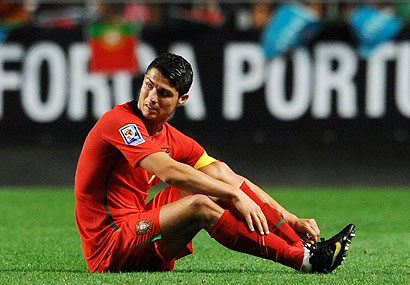How does sports lend itself to advertising on television? Television has transformed sports into a lucrative business, where the money made around the games is seen as more important than winning the contests. Are sports traditions compromised so they can be better received by television viewers?
History of Sports Television
Television in America was born at the opening ceremonies of the 1939 World's Fair when it was broadcasted on David Sarnoff's NBC network. Sarnoff declared " we have added sight to sound" and that it was bound to affect all of society. (Schwartz, 2002). Since the advent of radio Americans took to this medium for news and entertainment. A voice painted a picture of wars, comedy routines and of Babe Ruth smacking a homerun out of Yankee Stadium (Rader, 1984).
Although 1939 signaled the beginning of the television age, it was still at the early stages and open to experimentation. On May 17 1939, legendary radio broadcaster Bill Stern's voice came across the airwaves; along with it were live pictures of Baker Field at Columbia University. Several hundred at the RCA pavilion, including Orrin E. Dunlap Jr. of The New York Times, viewed the game (Rader, 1984). That following Sunday, Dunlap had this to say about televised baseball:
The televiewer lacks freedom; seeing baseball on television is too confining, for the novelty would not hold up for more than an hour, if it were not for the commentator.
To see the fresh green of the field as The Mighty Casey advances to the bat, and the dust fly as he defiantly digs in, is a thrill to the eye that cannot be electrified and flashed through space on a May Day, no matter how clear the air.
What would Christy Mathewson, Smokey Joe Wood, Home Run Baker, Eddie Collins, Frank Chance, Tris Speaker, Ty Cobb, Rube Marquard and those old timers think of such a turn of affairs- baseball from a sofa! (as cited in Rader, 1984,17)
Experimental network W2XBS continued to televise sporting events through 1939 and 1940. Some of which were the first professional sporting event televised in America between the Cincinnati Reds and Brooklyn Dodgers, and the first professional football game between the Brooklyn Dodgers and Philadelphia Eagles. Few fans watched these games because television sets were not selling due to lack of quality programming and little money from advertisers. Soon all television experimentations were ceased due to the war effort (Rader, 1984).
Two years before W2XBS began experimenting with televised sports, The BBC in London broadcasted all matches from Centre Court at Wimbledon. More than sixty years later the two-week tennis tournament put on by the All England Lawn and Tennis Club is still broadcast by the BBC and seen by a worldwide audience. The BBC continued broadcasting sporting events up until 1939, including soccer matches from Wembly Stadium and boat races. These were met with much success in England but were brought to a halt due to the Second World War (Barnett, 1990).
At the conclusion of the war television in the United States and England resumed. In America the golden age of television was on its way and it also brought upon the first era of television sports. The first era found sports easily controlled for large audiences to gain popularity. These sports included wrestling, roller derby, and boxing. Wrestling went from a mighty battle of grappling artists to a theatrical fight between good and bad. Roller Derby added fake violence to a sport were the goal is to skate oval, and boxing substituted slugfests for finesse fights (Rader, 1984).
In the 1960s color television, slow motion, and replays brought more control to outdoor team sports, such as baseball and football. Television audiences for these sports began to grow, hurting attendance. Colleges took action by reducing the number of games being telecast. Professional sports, such as the NFL, embraced television and used it to propel them into a form of entertainment.
The second era began with the increased popularity of football, and baseball on television and was officially set policy changes by the networks (Rader, 1984).
Prior to the 1960s, sports had small portions of network budgets and programming time. That changed when "doormat network", ABC, made sports the centerpiece of their programming. The boldest move was the launch of Monday Night Football. For the first time professional sports were up against programs like the movie of the week. This move propelled ABC to the top in ratings. By the mid 1970s, NBC and CBS would follow suit (Rader, 1984).
A war between the three major networks had begun. By the 1980s the hours of televised sports had doubled in comparison to ten years before. The rights to telecast professional and college sports along with the Olympics were driven to incredible amounts of money. Sports were packaged to be more appealing to television, in effect compromising the nature of the games (Rader, 1984).
The Commercialism of Sports
The second era has changed the landscape of both television and sports. The leagues and teams are bringing in millions of dollars from television contracts. The television networks pay for these contracts with the money they receive from advertisers paying for airtime on their telecasts of these sporting events. The effects that this money has caused since the beginning of the second era to know are insurmountable (Chandler, 1988).
The profitability of sports on television has caused leagues to expand to cities with large media outlets as well as to expand the length of their seasons. From this athletes have been put on a pedestal. They command large salaries and put a much larger strain on their bodies to perform than the players in the past (Klatell & Marcus 1988).
Television executives will point out that without the money from television, many events would not exist. To accommodate for television, sports have had to adjust schedules, the pace of games, and the locations. Professional baseball went from a sport played mostly in the afternoon to a game that is mostly seen now in the evening under artificial lights. Basketball, hockey, and football have added television timeouts to break for commercials. (Klattell& Marcus, 1988).
Television's influence has brought upon on-site banners, logo, and sponsor tie-ins. Arenas and stadiums are covered with billboards. The networks sell ad space for such things as the halftime report, or the official beer of the event (Klatell& Marcus, 1988). For example, NBC's coverage of the 2002 Winter Olympic Games used tie-ins along with commercial breaks. One of these tie-ins was the "Chevy Moments". These were personal profiles produced by NBC and sponsored by Chevy to attract viewers to some of the lesser-known athletes that are only heard of every four years (Goetz & Thomaselli, 2002). Another example is Tuner Sports' "AT&T Half Time Report," used for their NBA programming (Cassidy, 2001).
Regular sporting events usually bring in low ratings. In Television and National Sport, Chandler (1988) evaluated television ratings for the week of September 28, 1980. The highest rated sporting event was "Monday Night Football," and it was twenty-forth overall, behind hit shows of the time like Little House on The Prairie, and The Jefferson's. His research goes on to show that regularly scheduled sporting events fell short in the ratings.
The big ratings for sports come from the big events, such as the Super Bowl, World Series, and the Olympics (Chandler, 1988). Five of the top ten all time top rated programs in America are sporting events. Four of those are super bowls including "Super Bowl XVI," played in 1982 between The San Francisco 49ers and the Cincinnati Bengals, the highest rated sporting event. It pulled in a 49.1 rating, seen by nearly half of the television sets in America and it is fourth overall (Brown & Morrison, 2000)
The one high rated sporting event that is not a Super Bowl is, the women's figure skating final from the 1994 Winter Olympics. It is the third most watched sporting event and sixth overall with a 48.5 rating. It was so widely watched due to the circumstances involving two of the competitors, Tonya Harding, and Nancy Kerrigan (Brown & Morrison, 2000).
Normally, one of the largest television events of the year is the Super Bowl. Averaging nearly eighty millions viewers, the Super Bowl commands over two million dollars per thirty seconds of commercial time. Watching the commercials has become a separate part of the festivities. The Super Bowl held February 3, 2002 was not so super when it came to advertising. A mix of dealing with a sagging economy and competition from the Olympics being held the same month, took away from the normally biggest ad day of the year (Lowry, Khermouch & Grover, 2002).
For the first time the rate for commercial spots dropped. Although there was a drop, the Fox Network still managed profit over one hundred million dollars. Seventeen days of exposure on the worlds biggest stage was too enticing for such companies as Nike, and Volkswagen (Lowry, Khermouch & Grover, 2002).
Along with the seventeen days, another key reason for choosing the Olympics over the super bowl is women viewers. Advertisers choose to target women, with the logic that they do most of the shopping in American homes. Executive Vice President of NBC Olympics, David Neal said in Advertising Age (Goetz & Thomaselli, 2002) "figure skating is the crown jewel of any Winter Olympics. It appeals to all demographics, but particularly to women."




 11:55 AM
11:55 AM
 Humari news
Humari news















